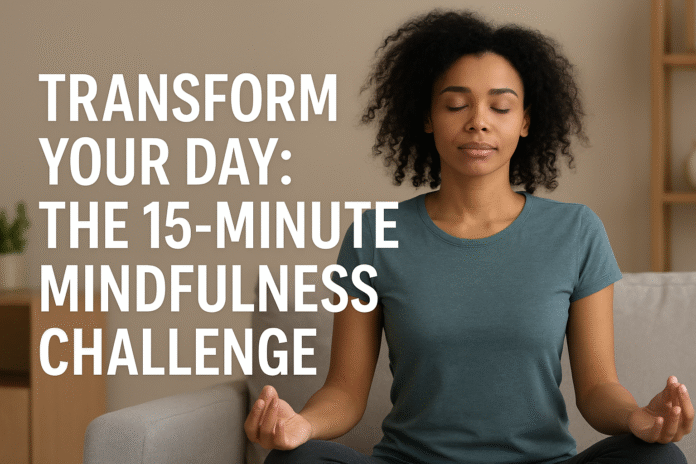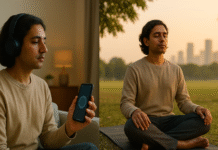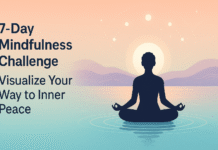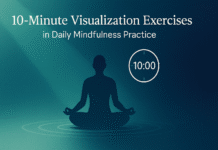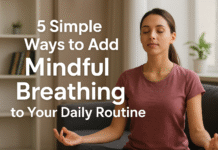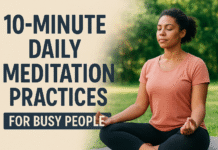Mindfulness doesn’t need to be a life overhaul. In fact, fifteen focused minutes a day can shift attention, calm reactivity, and build mental resilience that carries into the rest of your waking hours. This article is written for busy people—professionals, parents, students, and anyone who wants a simple, sustainable entry point into a mindful habit. You’ll learn what the 15-Minute Mindfulness Challenge is, why it works, how to do it (step-by-step), how to measure progress, safety caveats, and a practical 4-week starter plan that gets you from day one to a reliable daily practice.
Medical / mental-health disclaimer: this article is educational and not a substitute for individualized medical, psychiatric, or psychological advice. If you have a diagnosed mental-health condition, a history of trauma, psychosis, or are taking psychiatric medication, consult a qualified health professional before beginning a meditation practice.
Key takeaways
- Small, consistent practice works. Fifteen minutes daily is a practical “sweet spot” for building attention and reducing everyday stress while fitting into busy schedules.
- Structure matters more than duration. A clear, simple sequence (brief settling → focused attention → short reflection) maximizes benefit and reduces overwhelm.
- Be mindful of risk. For a minority, meditation can trigger distressing experiences; know the signs and have supports in place.
- Track what matters. Use adherence, perceived stress, mood check-ins, and simple behavior markers to measure progress.
- Four weeks builds habit. A structured 4-week roadmap with clear micro-goals helps convert the challenge into a lasting habit. (See the 4-week starter plan below.)
What the 15-Minute Mindfulness Challenge Is (and why it matters)
What it is and core benefits.
The 15-Minute Mindfulness Challenge is a structured daily routine: fifteen consecutive minutes of intentional mindfulness practice performed every day for a defined period (commonly 2–8 weeks). The goal is habit formation—creating a reliable slot in your day to cultivate attention, emotional balance, and clarity. People report lower stress, better focus, improved emotional regulation, and small but consistent improvements in mood and wellbeing after short, daily practice.
Why fifteen minutes?
Fifteen minutes strikes a balance: long enough to settle into attention and produce measurable effects, short enough to fit into busy days. Research finds that even 10 minutes can produce measurable wellbeing benefits for many people, and comparisons between 10 and 20 minutes show modest differences—so consistency matters more than an extra five or ten minutes.
Requirements / prerequisites (and low-cost alternatives).
- Time: 15 consecutive minutes daily.
- Space: A quiet corner, a chair or cushion. Any safe, comfortable place works.
- Tools (optional): Timer (phone or kitchen), a guided-audio track or app for beginners, and a notebook for brief reflections. Free guided sessions and timers suffice; no paid subscription is required.
- Cost: Minimal—mostly your time. Free and low-cost resources exist for guided practices and timers.
Step-by-step instructions (beginner-friendly).
- Choose a consistent daily window (e.g., morning after coffee, lunch break, or before bed). Consistency builds habit.
- Set a 15-minute timer—no need to watch the clock.
- Posture and beginning (2 minutes): Sit comfortably, spine upright but not rigid. Close or soften your gaze. Take 3 slow, full breaths to settle.
- Focused practice (10 minutes): Choose a focal anchor—breath, body sensations, or a guided audio. Rest attention on the anchor; when the mind wanders (it will), note the distraction briefly and gently guide attention back.
- Reflection and close (3 minutes): Do a quick body-scan from head to toes, note one word describing your present state (e.g., “soft,” “busy,” “calm”), and set a simple intention for the next hour (e.g., “I will pause once before reacting”).
- Record (optional, 30–60 seconds): Jot one sentence about how you feel or whether you met the time. This strengthens accountability.
Beginner modifications and progressions.
- Simplify: Start with two 7-minute mini-sessions per day if 15 consecutive minutes feels too long.
- Progress: After 2–4 weeks, increase to 20 minutes or add a second short period of mindful breathing later in the day. Some people progress to longer sits (30–45 minutes) as curiosity and capacity grow. Verywell Mind
Recommended frequency / duration / metrics.
- Frequency: Daily. Consistency is the primary driver of results.
- Duration: 15 minutes per session for the challenge; maintain or adjust after the challenge concludes. Research suggests 10–20 minute daily sessions are effective for many users.
- Metrics / KPIs: Days practiced per week (adherence %), self-rated stress (0–10), number of mindful pauses during the day, and mood check-ins (pre/post session).
Safety, caveats, common mistakes.
- Caveat: Some people experience distressing reactions (increased anxiety, resurfacing trauma). If practice triggers intense or lasting distress, pause and consult a mental-health professional.
- Common mistakes: Expecting immediate calm every session, forcing attention (rather than gently returning it), and multitasking while “meditating.” Avoid practicing excessively when very sleep-deprived or immediately after trauma-triggering events.
Sample mini-plan (2–3 steps).
- Day 1–7: 15 minutes each morning (2 minute settle → 10 minute breath focus → 3 minute reflection).
- Day 8–14: Add a single mindful 1-minute pause at lunch.
- Day 15–28: Maintain morning sit; optionally extend to 20 minutes twice a week.
The science in plain language: what research shows
What it is and core benefits.
A substantial body of research—from randomized trials to meta-analyses—shows that mindfulness practices produce small to moderate improvements in stress, anxiety, depression, and quality of life for many people. Mindfulness training can increase present-moment awareness, lower reactivity to difficult thoughts and emotions, and improve attention and working memory in some populations.
Requirements / prerequisites (for interpreting research).
- Understand variability: Effects vary by program type, participant baseline distress, and practice adherence. Evidence is strongest for structured programs (like eight-week MBSR/MBCT) but shorter home practices also show benefits. Nature
Step-by-step: translating research into practice.
- Choose a simple daily practice (15 minutes).
- Track adherence and subjective outcomes.
- After 4 weeks, evaluate patterns and decide whether to continue, extend duration, or seek guided instruction.
Beginner modifications and progressions.
- If you want a research-aligned program, consider an 8-week course or use a validated app for guided programs that follow evidence-based sequences. If you’re pressed for time, a 15-minute daily stand-alone practice still yields meaningful effects for many people.
Recommended frequency/duration/metrics.
- Research-based benchmark: Many clinical trials use daily practices of 20–45 minutes within an 8-week program; but shorter daily doses (10–15 minutes) have demonstrated benefits in modern trials and real-world studies. Track perceived stress and mood weekly.
Safety, caveats, common mistakes to avoid.
- Do not assume “one size fits all.” If you have a history of trauma or psychiatric diagnosis, seek adapted, trauma-informed instruction rather than unguided intensive practice.
Sample mini-plan (2–3 steps).
- Week 1: 15 minutes daily of breath awareness + weekly subjective stress rating.
- Week 2: Add a daily one-sentence reflection in a notebook.
- Week 3–4: Continue same practice and review weekly stress/mood graph.
Daily structure that maximizes a 15-minute session
What it is and core benefits.
A predictable internal structure helps the mind settle quickly and reduces decision fatigue. A simple three-part template works well: (A) arrival/settling, (B) core practice, (C) integration/close. This pattern increases the chance that the 15 minutes produce both immediate calm and carryover into daily life.
Requirements / prerequisites.
- A timer, comfortable seat, and an anchor (breath, body, or guided audio).
Step-by-step practical template (exact sequence).
- Minute 0–2 — Arrival: Seat, posture, 3 slow breaths, set intention.
- Minute 2–12 — Core practice (10 minutes): Focused attention on breath, body sensations, or felt sense. When distracted, label gently (e.g., “thinking”) and return. Use guided audio if helpful.
- Minute 12–15 — Integration: Short body scan (top to bottom), note one feeling word, set an intention (e.g., “pause before responding”), and open eyes slowly.
Beginner modifications and progressions.
- If 10 minutes of focused attention feels too long, do two 5-minute blocks with a 1-minute stretch between. Progress by increasing single-block focus time weekly by 1–2 minutes.
Recommended frequency/duration/metrics.
- Daily: 15 minutes using the above template.
- KPIs: Session completed (Y/N), number of re-directs (approximate), post-session calm rating (0–10).
Safety, caveats, common mistakes.
- Avoid forcing calm; practice is about noticing, not achieving a particular state. If sessions repeatedly trigger agitation or traumatic memories, stop and seek professional guidance.
Sample mini-plan (2–3 steps).
- Day 1–4: Follow the 3-part template exactly.
- Day 5–7: Add a 30-second gratitude note at the end.
Practical techniques you can use in 15 minutes
Below are four simple techniques that fit into a 15-minute challenge. Each technique includes how to do it, adjustments, frequency, and a micro-plan.
1) Breath Awareness (Focused Attention)
What it is and benefits.
Attention anchored to the breath strengthens concentration and reduces rumination.
Requirements / alternatives.
No equipment. Sit or lie down. If sitting is uncomfortable, do this practice while standing or walking slowly.
Step-by-step (15-minute version).
- 2 min: settle with three full breaths.
- 10 min: focus on the sensation of breath at the nostrils or chest. Label distractions gently and return.
- 3 min: body scan and reflection.
Modifications/progressions.
Start with 5 minutes; progress by 1–2 minutes per week. For more vivid focus, count breaths up to 10 and restart.
Recommended frequency/duration/metrics.
Daily 15 minutes; track days practiced and perceived focus after each session.
Safety/caveats.
Shallow breathing or hyperventilating can occur if you breathe forcefully; keep breath natural.
Mini-plan (2 steps).
- Week 1: 15 minutes daily breath awareness.
- Week 2: Add 2 short mindful breath pauses during work breaks.
2) Body-Scan Micro-Practice
What it is and benefits.
Systematically bringing attention through the body reduces tension and anchors attention in sensation.
Requirements / alternatives.
A chair or lying down; can be done standing if necessary.
Step-by-step (15-minute version).
- 2 min: settle.
- 10 min: scan from toes to head (or head to toes), lingering where sensation is strongest.
- 3 min: breathe into areas of tension.
Modifications/progressions.
Do a quick 5-minute scan when time is tight. Progress by slowing the scan or adding guided imagery.
Recommended frequency/duration/metrics.
Daily or 3–5 times weekly; note tension reduction on a 0–10 scale.
Safety/caveats.
If the scan brings up strong emotions, pause and shift to simpler breath anchoring or seek guidance.
Mini-plan (2 steps).
- Days 1–7: 15-minute morning body scans.
- Days 8–14: Add a 5-minute body scan before sleep.
3) Open Awareness (Choiceless Awareness)
What it is and benefits.
Rather than focusing on a single anchor, notice sounds, thoughts, sensations, and emotions without clinging. Great for cultivating spaciousness.
Requirements / alternatives.
Requires some practice; beginners may prefer breath focus first.
Step-by-step (15-minute version).
- 2 min: settle.
- 10 min: allow awareness to rest on whatever is present; note without judgment.
- 3 min: integration and naming one insight.
Modifications/progressions.
Begin with alternating 2 minutes breath / 2 minutes open awareness.
Recommended frequency/duration/metrics.
Daily 15 minutes; track moments of clarity or reactivity.
Safety/caveats.
Open awareness can feel unstructured and unsettling for some; if it triggers dissociation or distress, switch to breath focus.
Mini-plan (2 steps).
- Week 1: 10 minutes breath + 5 minutes open awareness.
- Week 2: 15 minutes open awareness (if comfortable).
4) Movement Mindfulness (Walking or Gentle Movement)
What it is and benefits.
Combines physical movement and mindful attention—useful for those who find stillness difficult.
Requirements / alternatives.
A short corridor or safe space to walk slowly.
Step-by-step (15-minute version).
- 2 min: set intention, stand.
- 10 min: walk slowly, notice sensations in feet and legs; synchronize attention with each step.
- 3 min: stillness and reflection.
Modifications/progressions.
If space is constrained, practice mindful stepping in place or gentle yoga stretches.
Recommended frequency/duration/metrics.
Daily or as needed; metric = number of mindful steps per minute or minutes of continuous awareness.
Safety/caveats.
Move safely; avoid busy streets during walking practice.
Mini-plan (2 steps).
- Days 1–14: 15-minute mindful walk after lunch.
- Days 15–28: add a 5-minute seated breath practice in the morning.
Measuring progress and outcomes
What it is and benefits.
Tracking creates objective evidence of behavior change and helps you iterate. For a short challenge, simple, low-friction measures win.
Requirements / tools.
Journal or digital note, simple weekly survey (0–10 ratings), and a calendar to mark completed days.
Step-by-step (how to track).
- Adherence: mark each day you complete the 15 minutes.
- Subjective outcomes: daily 0–10 ratings for stress, focus, and mood.
- Behavior markers: record one mindful behavior (e.g., paused before reply to an email) each day.
- Weekly review: average your ratings and note trends.
Beginner modifications and progressions.
If daily logging is too burdensome, log three times per week. Progress to adding minutes of silent practice as capacity increases.
Recommended frequency/duration/metrics.
Daily tracking for 4 weeks; KPIs: % adherence, mean stress reduction, number of mindful behaviors per week.
Safety, caveats, common mistakes.
Avoid turning tracking into perfectionism. Focus on trends, not every fluctuation.
Sample mini-plan (2 steps).
- Week 1: Track adherence and post-session calm rating.
- Week 2–4: Add weekly textual reflection and a one-line summary of lessons learned.
(Research supports that structured tracking and small, consistent doses delivered via digital interventions produce measurable benefits in stress and wellbeing.)
Common pitfalls and troubleshooting
What it is and core benefits.
Knowing common pitfalls prevents derailment and keeps practice enjoyable.
List of common problems and fixes
- “I can’t stop thinking.” Fix: Name the distraction (“thinking”) and gently return to the breath. Shorten the core practice initially if needed.
- “I feel sleepy.” Fix: try a standing or walking mindfulness session, or practice earlier in the day.
- “I get frustrated with myself.” Fix: reframe distraction as the moment to practice noticing—this is the practice.
- “It triggers tough memories.” Fix: pause practice, use grounding techniques, and seek trauma-informed guidance if distress is strong.
Step-by-step troubleshooting workflow.
- Identify the immediate issue.
- Apply the targeted fix.
- If unresolved for more than a week or if distress escalates, consult a trained teacher or mental-health professional.
Beginner modifications and progressions.
Use guided audios or short timers if wandering persists; gradually reduce dependence on guided tracks.
Sample mini-fix (2 steps).
- If sleepy: switch to mindful walking for one week.
- If triggered: reduce practice to 5 minutes breath focusing and seek professional support.
4-Week Starter Plan (the full roadmap)
What it is and benefits.
A practical, progressive plan that converts a short daily experiment into a more stable habit.
Week 1 — Planting the seed (Days 1–7)
- Goal: anchor the daily habit.
- Daily practice: 15 minutes morning breath awareness (2/10/3 template).
- Micro-tasks: set a consistent time, choose a seat, set timer, brief reflection after each session.
- Metric: Adhere to at least 5 of 7 days.
- Tip: Keep a visible sticky note reminder.
Week 2 — Build consistency (Days 8–14)
- Goal: deepen short practice and introduce a mindful pause.
- Daily practice: 15 minutes using the same template. Add a mindful 60-second pause at lunch.
- Metric: 6 of 7 days plus 4 mindful pauses.
Week 3 — Expand awareness (Days 15–21)
- Goal: diversify practice styles.
- Daily practice: 15 minutes (alternate breath, body scan, open awareness). Add one short mindful walk.
- Metric: 6 of 7 days + two different practice types.
Week 4 — Consolidate and reflect (Days 22–28)
- Goal: consolidate habit and measure outcomes.
- Daily practice: 15 minutes; pick preferred modality.
- Weekly review: chart adherence, average stress rating, note 3 examples of mindful behavior across the week.
- Decision point: continue 15-minute daily practice, extend duration, or take an advanced course.
Requirements / low-cost alternatives.
Use free guided tracks, a simple notebook, and your phone timer.
Safety / caveats / common mistakes.
Don’t push for “perfect” adherence; if you miss days, resume immediately the next day rather than punishing yourself.
Mini-plan (2 steps).
- After 4 weeks, schedule a personal check-in to adjust time of day or technique.
- If you enjoyed the challenge, consider joining a weekly drop-in class or a guided 8-week program.
Safety, ethics, and when to stop
What it is and core benefits.
Mindfulness is safe for most people but not universally so. Awareness of risks builds responsible practice.
Known risks and prevalence.
Research notes that while benefits are common, a minority of practitioners report adverse experiences such as increased anxiety, re-experiencing trauma, or transient changes in perception. Across some studies, small percentages experienced lasting negative effects; other observational work shows higher transient rates—underscoring the need for careful, supported practice in vulnerable groups.
Requirements / preventive measures.
- If you have significant mental-health history, seek guidance from a trauma-informed teacher or clinician before increasing practice.
- Keep practice brief and grounded; include body-based anchors and movement options.
- Always have a way to contact a trusted person or professional if distress arises.
Step-by-step for addressing adverse reactions.
- Stop formal practice and use grounding techniques (feet on floor, 5 deep breaths).
- If distress persists, contact a mental-health provider.
- Consider adapted approaches (trauma-sensitive mindfulness or shorter sessions).
Common mistakes to avoid.
- Minimizing or normalizing strong negative experiences (“push through” mentality).
- Isolating practice without support when you have complex trauma.
Sample mini-plan (2 steps).
- If a session triggers intense emotion, switch to mindful movement and seek support that day.
- If symptoms persist beyond a week or impair functioning, stop solo practice and consult a provider.
Frequently Asked Questions (8–12)
- Q: Do I need special training to do the 15-Minute Mindfulness Challenge?
A: No. The challenge is designed for beginners. Use guided audios initially if you prefer structure, and consider a certified teacher for deeper practice. - Q: Is 15 minutes enough to experience benefits?
A: Yes—research shows that even 10–15 minutes of daily practice yields measurable wellbeing benefits for many people, though results vary. Harvard Health - Q: What if I miss a day or two—will it ruin the benefits?
A: No. Habit formation is resilient to occasional missed days. Return the next day and continue. Focus on overall trend, not perfection. - Q: Which time of day is best?
A: Morning supports habit formation for many, but lunch or evening works if that’s when you can be consistent. Choose a sustainable slot. - Q: Can mindfulness replace therapy for anxiety or depression?
A: Mindfulness can help reduce symptoms for many people, but it is not a guaranteed replacement for psychotherapy or medication in clinical cases. Consult a mental-health professional for personalized recommendations. - Q: Will mindfulness make me less emotional or more robotic?
A: No. Mindfulness aims to increase awareness and choice, not numbness. Over time people often report more emotional clarity and better regulation. - Q: How quickly will I notice results?
A: Some people notice immediate calm after a session; measurable changes in mood or stress often appear with consistent practice over 2–8 weeks. - Q: Are there any harms to practicing daily?
A: Most people tolerate daily practice well, but a minority experience distressing reactions. Start gently and seek support if difficult symptoms emerge. - Q: What if I fall asleep during practice?
A: Try a seated posture or mindful walking. Sleepiness can be a sign of sleep debt—address rest and adjust timing. - Q: Should I use an app or a live teacher?
A: Apps are convenient and evidence shows they can be effective. Live instruction is preferable if you have complex needs or desire more tailored guidance. - Q: How do I know if I’m “doing it right”?
A: There is no perfect session. Notice your ability to return attention; that returning is the skill. - Q: Can children or adolescents do the 15-minute challenge?
A: Shorter, age-appropriate practices (3–10 minutes) work better for younger children. Consult parents, teachers, or pediatric providers for guidance.
Troubleshooting checklist (quick-start)
- Choose a 15-minute window and set a recurring calendar reminder.
- Create a simple physical cue (a cushion, a mug) that signals practice time.
- Use a timer that gently rings (no startling alarms).
- If wandering is frequent, use guided audio for the core 10 minutes.
- Track one metric (adherence or stress rating) to maintain accountability.
- If practice causes distress, pause and seek professional help.
Final thoughts (conclusion)
The 15-Minute Mindfulness Challenge is a practical, evidence-aligned way to make mindfulness part of daily life without dramatic disruption. Fifteen minutes a day builds attentional muscle, improves stress reactivity for many people, and gives you a portable skill that improves decision making, emotional balance, and presence. Start small, track honestly, and treat the challenge like an experiment: observe, adjust, and enjoy the subtle shifts that accumulate over weeks.
Call to action: Start today—set a 15-minute timer and try the three-part template once; notice one difference at the end.
References
- Meditation programs for psychological stress and well-being. JAMA Internal Medicine (PubMed). 2014. . PubMed
- The effect of ten versus twenty minutes of mindfulness meditation on state anxiety and state mindfulness. Scientific Reports. 2023. . Nature
- Mindfulness-based stress reduction for healthy individuals (meta-analysis). PubMed. 2015. . PubMed
- What Are Adverse Events in Mindfulness Meditation? — PMC (open access). 2022. . PMC
- A Systematic Review and Meta-Analysis of Mindfulness. PMC (open access). 2021. . PMC
- Just 10 minutes of mindfulness daily boosts wellbeing and fights depression (University press release summarizing research). University of Bath. 23 August 2024 (updated March 2025). . University of Bath
- Effects of Mindfulness Meditation Duration and Type on Well-being — PMC. 2023. . PMC
- A meta-analysis: Internet mindfulness-based interventions for stress — PMC. 2020. . PMC
- Making mindfulness meditation more helpful starts with recognizing adverse effects (research summary). Brown University news. 2021. . Brown University
- Effectiveness of Daily Mindfulness Meditation App Usage to Reduce Anxiety (study) — PMC. 2023. . PMC




























